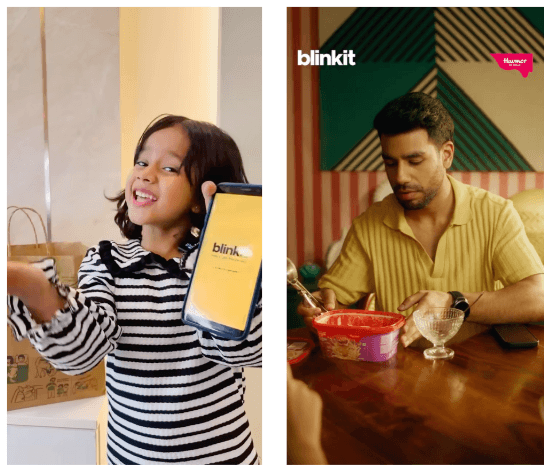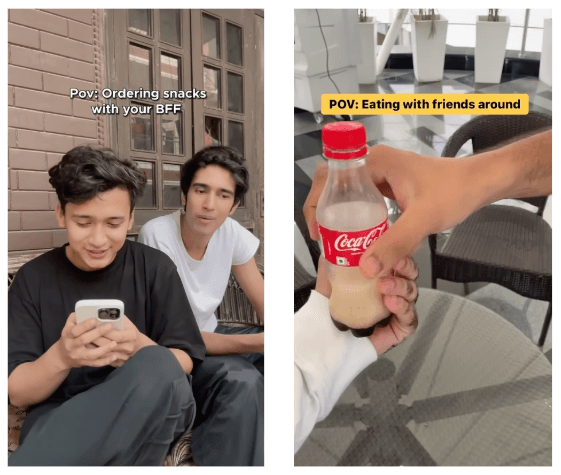Hidden Patterns in Top-Performing Creatives: Decoding Blinkit's Winning Formula
What happens when you analyze the top-performing video ads from a leading quick-delivery app using systematic creative intelligence? You discover the exact patterns driving success.
Introduction: Why Winning Creative Pattern Recognition Matters Now
Picture this: You're staring at a dashboard showing declining ROAS across your campaigns. Your latest batch of "winning" creatives that performed amazingly two weeks ago are now hemorrhaging budget. Sound familiar?If you're an experienced UA manager, you've lived this nightmare. The creative that drove 40% of your conversions last month suddenly can't crack a 1.0 ROAS. Meanwhile, your competitors seem to have cracked some secret code, consistently launching videos that resonate with audiences month after month.
Here's the uncomfortable truth: Most performance marketers are flying blind when it comes to creative strategy. We optimize bidding algorithms down to the cent, but treat creative development like throwing darts in a dark room.
What if I told you there's a systematic approach to decode exactly why certain creatives work (and more importantly, predict what will work next)? This isn't about gut feelings or creative "intuition." This is about creative intelligence: the systematic analysis of creative patterns, elements, and correlations that drive performance. Learn more about creative pattern recognition with Segwise.
TLDR: What You'll Learn
- The specific creative patterns that dominate quick-delivery app advertising
- Why UGC format drives 72.7% of successful campaigns in this vertical
- Three winning creative formulas you can adapt for any app or D2C brand
- How to implement creative intelligence to predict your next winning creative
The Problem With Traditional Creative Analysis
Most UA managers approach creative analysis like this:
- Launch 10 new video creatives
- Wait 48-72 hours or even a week for statistical significance
- Kill the losers, scale the winners
- Repeat until something sticks
This approach has three fatal flaws:
- Flaw #1: No Pattern Recognition You're optimizing individual creatives instead of understanding the underlying patterns that make creatives successful. When a video performs well, you don't know which specific elements drove that performance.
- Flaw #2: Reactive Instead of Predictive By the time you identify a winning creative, you're already behind. The market has moved, and your "winning" pattern is becoming saturated.
- Flaw #3: Creative Intelligence Deficit You're missing the systematic approach to understand why certain combinations of elements work together, leaving you unable to replicate success consistently.
Decoding Blinkit's Creative Dominance
The Data Reveals Clear Patterns
Here's what the analysis revealed from Blinkit's top performers:
Duration Mastery:
- 77.3% of top creatives are 0-15 seconds (average: 15.5 seconds)
- Only 4.5% exceed 46 seconds
- Strategic insight: Ultra-short content maximizes attention span utilization while fitting social platform algorithms. 73% of consumers use short-form videos when searching for new products, and the average viewer spends 1 hour and 16 minutes daily watching them.
Production Style Dominance:
- 72.7% use UGC (User-Generated Content) format
- 22.7% use Animation
- 4.5% other formats
- Strategic insight: Authenticity trumps high production value in quick-delivery verticals.UGC ads receive 20-50% more attention than branded ads, and 85% of people say that UGC influences them more than branded content (Goodway Group).

Audio Strategy Intelligence:
- 50% use Music + Added Sound Effects combinations
- Only 13.6% include voiceover in their top performers
Entertainment elements in short videos significantly enhance consumer trust and brand connection (PMC12075488).
The POV Social Scenario Revolution
The most striking pattern? 40.9% of successful ads use POV (Point of View) social scenarios. These aren't just videos. They're relatable moments that trigger psychological ownership.The emotionality of short videos significantly affects consumer engagement (ProQuest Research).Common POV scenarios driving performance:
- "POV: you have a sibling" (food protection dynamics)
- "POV: Eating with friends around" (social sharing anxiety)
- "POV: Craving hits at midnight" (instant gratification needs)
Why POV scenarios work: They're not watching an ad. They're experiencing a relatable moment.

The Psychology Behind The Winning Patterns
Why Ultra-Short Content Dominates
The 77.3% preference for 0-15 second content isn't arbitrary. It's based on three psychological principles:
- Attention span optimization: Mobile users make skip/continue decisions within 3 seconds
- Algorithm preference: Social platforms favor shorter content in recommendation engines.(ScienceDirect Study)
- Cognitive load theory: 15 seconds is optimal for single-concept comprehension without fatigue
The UGC Authenticity Factor
Why do 72.7% of top performers use UGC format? Because authenticity creates trust faster than polish:
- Reduced ad resistance:UGC feels less like advertising, more like peer recommendation
- Higher relatability: Real people in real scenarios mirror audience experiences.Consumers are 2.4x more likely to view UGC as authentic than branded content, and 70% will read at least one UGC review before purchase (Power Digital Marketing).
- Cost efficiency:UGC production costs 60% less than studio-produced content
Audio Strategy Without Dialogue Dependency
The minimal use of hook dialogue (most ads rely on visual storytelling) reveals sophisticated audience understanding:
- Silent consumption context:Many users scroll with sound off initially
- Universal accessibility:Visual storytelling transcends language barriers
- Cognitive efficiency:Viewers process visual information significantly faster than spoken words
Three Winning Patterns You Can Implement
Pattern #1: The Social Validation Hook
What Blinkit does: Shows relatable social scenarios where the app solves awkward moments
The formula: POV perspective + Social pressure + Instant solution
Application for Other Apps/Brands:
Fitness Apps:
- "POV: Your workout buddy cancels last minute"
- Show phone with disappointed text message
- Cut to person working out solo with app guidance
- End with "Never skip a workout again"
E-commerce/D2C Brands:
- "POV: You wore the same outfit to two events this week"
- Show closet dilemma from first-person view
- Transition to easy online shopping solution
- CTA: "Fresh looks delivered tomorrow"
Finance Apps:
- "POV: Splitting dinner bill gets awkward"
- Show hands fumbling with cash and calculators
- Demonstrate instant split payment solution
- End with "Split bills, not friendships"
Why it works: Taps into universal social anxiety and offers immediate resolution.
Pattern #2: The Speed-Focused CTA Strategy
What Blinkit does: 57.1% of their CTAs emphasize speed and immediacy
The formula: Problem recognition + Time-based urgency + Clear action
Application for Other Apps/Brands:
Productivity Apps:
- Instead of "Organize your life"
- Try "Get organized in 5 minutes"
- Or "Tomorrow starts now"
Subscription Services:
- Instead of "Join our platform"
- Try "Start streaming tonight"
- Or "Access everything instantly"
Retail/D2C:
- Instead of "Shop our collection"
- Try "In your hands by tomorrow"
- Or "Skip the store, get it faster"
Why it works: Time-based urgency creates immediate action impulse, outperforming feature-focused messaging.
Pattern #3: The Lifestyle-First Approach
What Blinkit does: 63.6% avoid showing app functionality, focusing on lifestyle scenarios
The formula: Relatable situation + Emotional connection + Subtle product integration
Application for Other Apps/Brands:
Travel Apps:
- Lead with the vacation moment (sunset dinner, adventure photo)
- Show the emotional payoff, not the booking interface
- End with simple "Plan your escape" prompt
Fashion/Beauty D2C:
- Focus on the confidence boost, compliments received
- Show lifestyle transformation, not product features
- Subtle brand integration in final frame
Productivity/Work Apps:
- Lead with the achievement moment (presentation success, early finish)
- Show work-life balance benefit, not software features
- End with "Reclaim your time" messaging
Why it works: Emotion drives decision-making. Features justify decisions already made.
Advanced Creative Intelligence: What The Correlations Reveal
UGC + Short Duration = Performance Amplification
- UGC ads average 15.1 seconds vs. Animated at 16.2 seconds
- Shorter UGC content shows stronger performance patterns
- Application:When using authentic footage, prioritize tight editing over comprehensive storytelling
The Inverse App Depth Relationship
- Top performers avoid detailed app functionality demonstrations
- Lifestyle-focused content consistently outperforms feature showcases
- Application:Lead with emotion and context, not capabilities
Audio Layering Without Voiceover Dependency
- Music + Sound Effects combination dominates successful campaigns
- Voiceover appears in only 13.6% of top performers
- Application:Invest in high-quality sound design over voice talent
Correlation analysis like this is made seamless with Segwise's dashboard and creative analytics suite.
The Competitive Intelligence Opportunity
What Other Apps Can Steal From Blinkit
The POV Social Formula (Used in 40.9% of top performers)
- Create first-person scenarios that trigger relatability
- Focus on social dynamics and peer pressure moments
- Use "POV:" text overlay to immediately establish perspective
The Ultra-Short Optimization Strategy
- Prioritize 15-second creative formats
- Front-load key messaging in first 3 seconds
- End with clear, speed-focused CTAs
The Authenticity Over Production Value Approach
- Invest in UGC-style content over high-budget productions
- Use real hands, real interactions, real environments
- Layer authentic sounds over polished music tracks
Underutilized Opportunities in the Market
Based on the analysis, here are creative territories with low competition:
- Voiceover storytelling: Only 13.6% usage suggests differentiation opportunity
- Educational content: Minimal app functionality showcase leaves knowledge gap
- Seasonal scenarios: Limited trend integration in current top performers
Implementing Creative Intelligence in Your Campaigns
Phase 1: Pattern Recognition
Start by analyzing your existing top performers through a systematic lens:
- What production styles dominate your best creatives?
- Which narrative approaches consistently drive performance?
- How do your successful creatives handle audio strategy?
Phase 2: Competitive Analysis
Apply the same framework to competitor creatives:
- Identify patterns your competitors use that you don't
- Spot oversaturated creative territories to avoid
- Find underexplored opportunities in your vertical
Phase 3: Predictive Creative Development
Use pattern insights to inform new creative briefs:
- Specify production style based on performance data
- Include narrative structure elements that correlate with success
- Design audio strategy around proven performance patterns
Phase 4: Systematic Testing
Test creative hypotheses methodically:
- Isolate specific pattern elements in A/B tests
- Track performance correlations over time
- Build a database of what works for your specific audience
Key Takeaways: From Creative Guesswork to Strategic Advantage
The Blinkit analysis reveals that successful creative strategy isn't about artistic inspiration. It's about systematic pattern recognition and strategic application.
The core insights:
- UGC authenticity beats production polish(72.7% of top performers)
- Ultra-short content maximizes engagement(77.3% under 15 seconds)
- POV social scenarios drive highest relatability(40.9% usage rate)
- Speed messaging outperforms feature focus(57.1% emphasize immediacy)
- Lifestyle context trumps app functionality(63.6% avoid detailed demos)
Your implementation roadmap:
- Analyze your current top performers for systematic patterns
- Study competitor creatives through the same analytical lens
- Apply proven patterns to new creative briefs
- Test pattern hypotheses systematically
- Build predictive creative capabilities over time
The creative landscape shifts faster than ever. Audiences become saturated with winning patterns within weeks, not months. The only sustainable advantage is the ability to identify what's working now and predict what will work next.
The question isn't whether creative intelligence will become standard practice. It's whether you'll implement it before or after your competitors gain the advantage.

Comments
Your comment has been submitted successfully!